Integrated Pest Management
Common Turf Diseases in Utah
 Irregular patches of dead turf. The circles with a pinkish hue are pink snowmold, those with a lighter (almost bleached) appearance are gray snow mold infections.
Irregular patches of dead turf. The circles with a pinkish hue are pink snowmold, those with a lighter (almost bleached) appearance are gray snow mold infections.
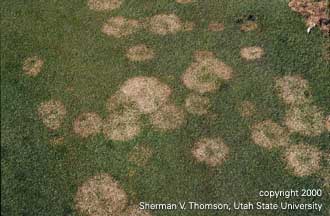 Gray and pink snow mold infections. Those with pink borders are pink snow mold and those lighter infections with less marked lesions are gray snow mold infections.
Gray and pink snow mold infections. Those with pink borders are pink snow mold and those lighter infections with less marked lesions are gray snow mold infections.
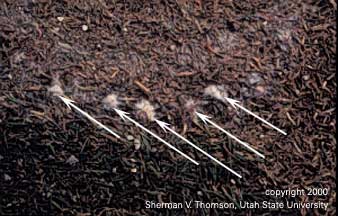 Arrows indicating sporodochia (spore masses) produced by the pink snowmold fungus.
Arrows indicating sporodochia (spore masses) produced by the pink snowmold fungus.
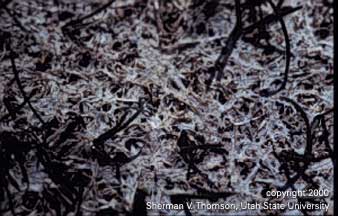 Hyphal mat produced by the gray snowmold fungus. Dead patches of grass, usually with a gray-white hyphal mat are symptoms of a gray snowmold infection.
Hyphal mat produced by the gray snowmold fungus. Dead patches of grass, usually with a gray-white hyphal mat are symptoms of a gray snowmold infection.
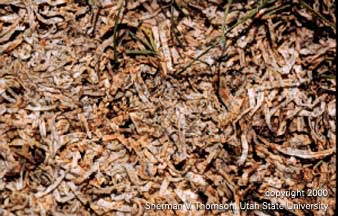 Matted patch of grass infected with the gray snowmold fungus.
Matted patch of grass infected with the gray snowmold fungus.
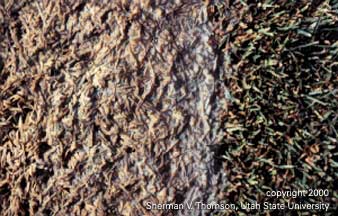 Advancing border of turf infected with a snowmold fungus.
Advancing border of turf infected with a snowmold fungus.
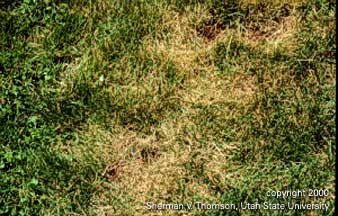 Thinning and necrosis of grass, common when Melting Out fungi are infecting the plant tissues.
Thinning and necrosis of grass, common when Melting Out fungi are infecting the plant tissues.
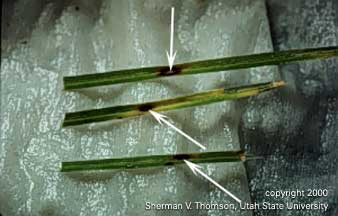 Characteristic Melting Out lesions indicated by the arrows. Lesions are brownish-purple and circular to oval in shape with straw colored centers.
Characteristic Melting Out lesions indicated by the arrows. Lesions are brownish-purple and circular to oval in shape with straw colored centers.
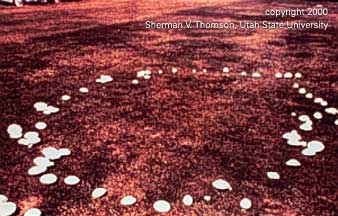 Fairy Ring with active fungal reproductive structures (mushrooms).
Fairy Ring with active fungal reproductive structures (mushrooms).
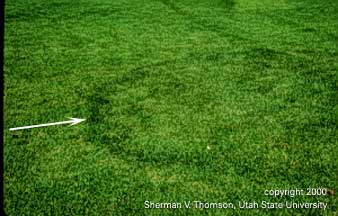 Circle of dark green grass as indicated by the arrow shows the active edge of the fairy ring. Vegetative portions of the causal fungus will continue to radiate outward periodically producing mushrooms.
Circle of dark green grass as indicated by the arrow shows the active edge of the fairy ring. Vegetative portions of the causal fungus will continue to radiate outward periodically producing mushrooms.
SPRING DISEASES
PINK SNOW MOLD
Cause: Fusarium nivalis--fungus
Importance: Major problem in late fall and early spring. Snow cover not necessary.
Symptoms: Irregular patches with light pink margins.
Control:
1. Avoid heavy fertilization in the fall.
2. Avoid heavy snow accumulations when shoveling snow.
3. Apply fungicides to previously affected areas in fall and spring.
Fungicides:* Banner, Bayleton, Chipco 26019, Cleary 3336, Fore, Fungo, Rubigan, Terraclor (PCNB), Thiram, Vorlan
GRAY SNOW MOLD
Cause: Typhuyla spp.--fungus
Importance: A serious problem where persistent snow cover is common.
Symptoms: Dead patches of grass in the spring; presence of sandgrain-sized, brown fungal sclerotia embedded in dead leaf tissue.
Control:
1. Avoid heavy snow accumulations when shoveling snow.
2. Physically spread piles of snow or apply black fly ash or graphite to hasten snow melt.
3. Apply fungicide in late fall where snow mold has been a problem.
Fungicides:* Banner, Bayleton, Chipco 26019, Dyrene, Prostar, Rubigan, Terraclor (PCNB), Thiram
MELTING OUT
Cause: Helminthosporium-like spp.--fungus
Importance: Prevalent every year. Major reason for dead areas in turf.
Symptoms: General thinning of grass. Circular purplish-brown to dark brown rings around straw-colored spots on leaf blades.
Control:
1. Aerate to reduce thatch in early spring.
2. Avoid a single heavy application of soluble nitrogen in the spring.
3. Water infrequently but deeply.
4. Mow at 2.5 - 3 inches during hot weather.
5. Apply fungicide to areas where problem has occurred in previous years.
Fungicides:* Banner, Chipco 26019, Cleary 3336, Curalan, Daconil, Dyrene, Fore, Terraclor (PCNB), Vorlan
SUMMER DISEASES
NECROTIC RING SPOT
Cause: Ophiosphaerella korrae--fungus
Importance: Can be a serious problem in spring and fall.
Symptoms: Dead circles or arcs that range in size from several inches to several feet in diameter. Microscopic dark hyphae can be found on the grass crowns. Difficult to control even with fungicides.
Control:
1. Aerate to reduce thatch in early spring.
2. Nitrogen fertilizer should be applied frequently and at low rates when the grass is actively growing. Use an acid type fertilizer like ammonium sulfate.
3. Keep mowing height at 2.5 - 3 inches.
4. Water infrequently but deeply.
5. Apply fungicides where necrotic ringspot has been a problem.
6. Replant with several grass species with resistance.
Fungicides:* Chipco 26019, Fungo, Rubigan, Banner Max, Heritage, Eagle, Sentinel
SUMMER PATCH
Cause: Magnaporthe graminicola--fungus
Importance: Can be a serious problem . May be present during the summer.
Symptoms: Dead circles or arcs that range in size from several inches to several feet in diameter, indistinguishable from necrotic ring spot. Microscopic dark hyphae can be found on the grass crowns. Difficult to control.
Control:
1. Aerate to reduce thatch in early spring.
2. Nitrogen fertilizer should be applied frequently and at low rates when the grass is actively growing.
3. Mow at 2.5 - 3 inches.
4. Water infrequently but deeply.
5. Apply fungicide where the disease has occurred.
6. Replant with several grass species with resistance.
Fungicides:* Banner, Bayleton, Fungo, Rubigan, Alamo, Tilt, Sentinel, Intercept, Eagle, Cleary's 3336, Topsin, Heritage, Abound, Fungicide IX.
FAIRY RlNG
Cause: Various basidiomycete fungi
Importance: Common but only important in a few situations.
Symptoms: Circle of dark green grass with mushrooms forming in the band. Occasionally, the grass dies within the ring.
Control:
1. Keep turf adequately fertilized to promote even turf growth and color.
2. Aerate or use surfactants to improve water penetration into rings. Silicone surfactants work best.
3. If problem is severe, kill grass with glyphosate herbicide, rototil, and replant.
4. Prostar fungicide* provides suppression.
POWDERY MILDEW
Cause: Erysiphe graminis--fungus
Importance: Common but causes minor damage.
Symptoms: White powder on leaves, especially in shady areas.
Control:
1. Do not plant turf in heavy shade.
2. Prune trees and shrubs to enhance light penetration.
3. Water infrequently but deeply.
4. Plant shade-adapted varieties (fescue).
5. Apply fungicides to turf with a history of mildew.
Fungicides:* Banner, Bayleton, Rubigan
*Some of the fungicides listed are not readily available for home lawn use but can be obtained from commercial businesses or applied by a commercial operator.

